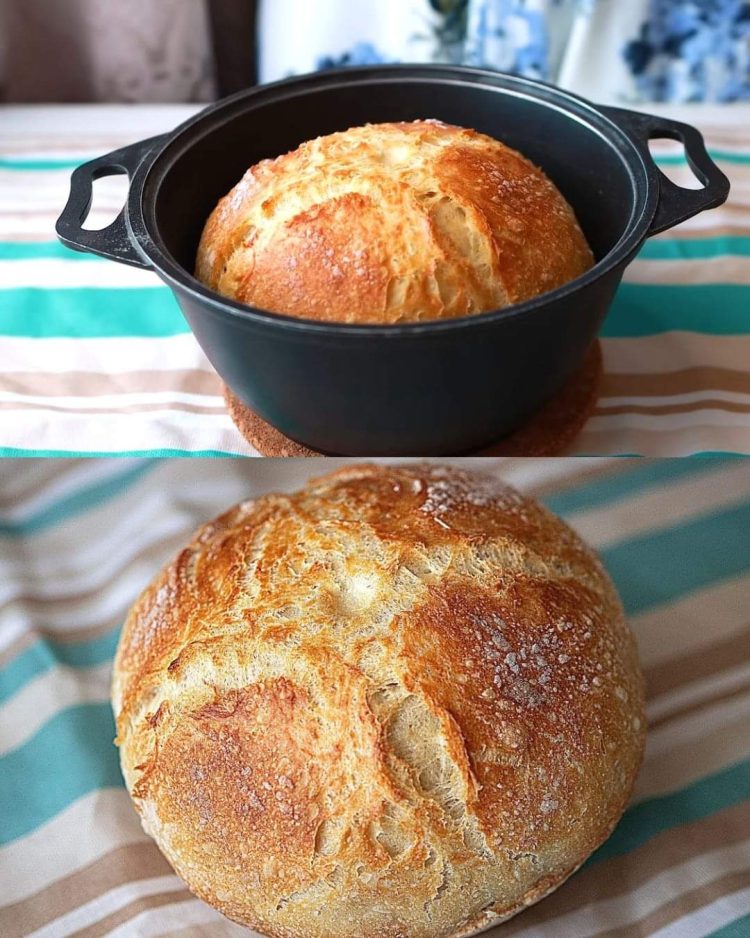Instructions
1. Activate the Yeast:
- In a large bowl, mix the lukewarm water (370 ml) and dry yeast (10 g). Stir gently and let it sit for 5-10 minutes until the yeast is dissolved and bubbly.
2. Make the Dough:
- Add the flour (500 g) and salt (1 teaspoon) to the yeast mixture. Stir with a wooden spoon or your hands until a lumpy dough forms.
3. Knead the Dough:
- Transfer the dough to a lightly floured surface and knead by hand for 8-10 minutes until it is soft and elastic. If the dough is too sticky, gradually add a bit more flour, one spoonful at a time.
4. First Rise:
- Place the dough in a clean bowl lightly oiled to prevent sticking. Cover it with a damp cloth and let it rise in a warm place for 1-2 hours, or until it has doubled in size.
5. Shape the Dough:
- Gently punch down the risen dough to release any air bubbles. Shape the dough into a loaf or your preferred shape, and place it on a baking sheet lined with parchment paper or in a greased loaf pan.
6. Second Rise:
- Cover the dough with a cloth and let it rise for another 30-45 minutes, or until it has doubled in size again.
7. Bake the Bread:
- Preheat your oven to 200°C (400°F). Bake the bread for 25-30 minutes, or until the crust is golden brown and the loaf sounds hollow when tapped on the bottom.
8. Cool and Serve:
- Remove the bread from the oven and allow it to cool on a wire rack before cutting. Enjoy your freshly baked bread warm or at room temperature!
Tips
- Softening the Crust: Brush melted butter on top of the bread after baking for a softer crust.
- Add-Ins: Feel free to include seeds, nuts, or herbs in the dough for extra flavor and texture.
Commonly Asked Questions
Can I use instant yeast instead of dry yeast? Yes, you can use instant yeast. If using instant yeast, mix it directly with the dry ingredients without needing to activate it separately.
How can I tell if my yeast is still good? Combine the yeast with lukewarm water and a little sugar. If it becomes bubbly within 5-10 minutes, it’s active. If not, it may be expired, and you should use a new batch.
Can I make this bread gluten-free? Yes, use a gluten-free flour blend suitable for bread. Gluten-free doughs may require special handling and more time to rise, so adjust as needed.
How can I make the outer layer less hard? To soften the crust, brush melted butter on top or cover it with a clean, damp cloth right after baking.
Can I add extra ingredients like seeds, nuts, or herbs? Absolutely! Incorporate seeds, nuts, or herbs into the dough for added flavor and crunch.
What if my dough is too wet? If your dough is sticky, gradually add more flour, one spoonful at a time, until it becomes smooth and manageable.
How should I store the bread? Store the bread in a bread box or a sealed plastic bag at room temperature for up to 3 days. For longer storage, freeze it in a sealed container or freezer bag for up to 3 months.
Can I prepare the dough in advance? Yes, you can refrigerate the dough after the first rise. Let it come to room temperature and rise again before shaping and baking.
Why did my bread turn out heavy? Heavy bread may result from under-kneading, insufficient rising time, or old yeast. Ensure thorough kneading and adequate rising time, and check the freshness of your yeast.
Can I use a bread machine? Yes, you can use a bread machine by following the manufacturer’s instructions for your specific model. Typically, you’ll add the ingredients in the order suggested by the machine, usually starting with the wet ingredients followed by the dry ones.
